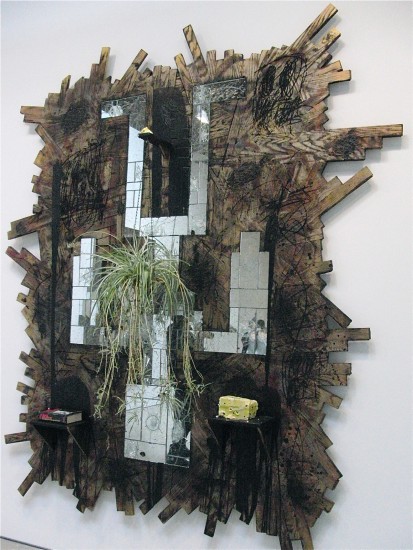
Rashid Johnson’s “Antoine’s Organ” features AudioBlk playing piano inside massive grid construction (photo by twi-ny/mdr)
Hauser & Wirth
511 West 18th St. between Tenth & Eleventh Aves.
Tuesday – Saturday through October 22, 10:00 am – 6:00 pm
212-790-3900
www.hauserwirth.com
Rashid Johnson continues his exploration of black selfhood and identity — for both himself and the viewer — in the extraordinary and subtly powerful four-part multimedia exhibition “Fly Away,” continuing at Hauser & Wirth through October 22. The Brooklyn-based artist first came to prominence when photographs he took for a Columbia College Chicago class were included in Thelma Golden’s seminal 2001 “Freestyle” group show at the Studio Museum in Harlem; he later created such provocative series and installations as “The New Negro Escapist Social and Athletic Club,” “Souls of Black Folk,” and “New Growth.” Johnson, who was raised in and around Chicago in an Afro-centric household — his mother is a poet and a professor of African history, his father is a painter and sculptor who works in electronics, and his stepfather is from Nigeria — delves into the black experience in America and across the African diaspora in the new show, which takes its title from the gospel favorite “I’ll Fly Away,” while “Cosmic Slop,” which Johnson also employs in describing his work, references the 1973 album by George Clinton and Funkadelic. In the first room, visitors are greeted by “Untitled Anxious Audience,” a half-dozen large-scale works that consist of dozens of faces scratched into black wax and black soap on grids of white bathroom tiles, an expansion of last year’s “Anxious Men” at the Drawing Center. Johnson’s process begins when he puts the tiles together on the floor of his studio, then pours hot black wax and soap over them, giving him a limited amount of time to shape and scratch in the faces as the mixture dries. He does not make the faces in any specific order; blank spaces are merely areas he didn’t get to, although they also have a distinct feel of absence, particularly in an era when black men are being shot and killed by police at an alarming rate. The pieces also reference feces, black substances in bathrooms, as well as bathhouses, which are often used as business meeting places for men. Each face looks out at the viewer, evoking a mirror, as if we are really looking at ourselves, while also serving as witnesses to violence, poverty, and racism. In the next room, three of Johnson’s “Falling Man” sculptures surround a long, rectangular walnut table with mounds of yellow shea butter on a Persian rug; shea butter is another of Johnson’s favorite materials and one that is also deeply connected to African and Afro-American culture. Each “Falling Man” is centered by an upside-down figure on white tiles, recalling a video-game character, 9/11 victim, or chalk outline of a body; the works also include broken mirrors, splotches of dripping black soap and wax, star-shaped cutouts of his father, oak flooring as if from a suburban basement, spray paint, a book (Harry Haywood’s Black Bolshevik), and plants, examining life and death from numerous angles.

Rashid Johnson, “Falling Man,” burned red oak flooring, spray enamel, mirror, black soap, wax, shea butter, book, plant, 2015 (photo by twi-ny/mdr)
In a third room, three of Johnson’s “Untitled Escape Collages” hang on the walls, grids of white and color tiles on which Johnson has added vinyl stickers of scenes with palm trees and other plants, flowery wallpaper, drips of black soap and wax, spray paint, and another cutout of his father (standing in front of a CB radio — his father is a CB aficionado — and showing off his green belt in martial arts), all coming together to represent the dreams Johnson had of escaping to another world. “As a kid I remember thinking that if you could actually live in a place with palm trees, if you could get away from the city and the cold, that meant you’d definitely made it,” he has said. The pièce de résistance is “Antoine’s Organ,” a massive latticework construction that is filled with living plants in colorful decorative pots handmade by Johnson, books about the black experience (Ta-Nehisi Coates’s Between the World and Me, Paul Beatty’s The Sellout, Randall Kennedy’s Sellout: The Politics of Racial Betrayal, a twelve-steps book that references Johnson’s two years of sobriety), CBs, skulls made out of “traditional handcrafted sheabutter” from Ghana, and small, old-fashioned monitors looping four of Johnson’s short films, two of which he appears in. On Tuesdays and Wednesdays from 3:00 to 5:00 and Saturdays from 1:00 to 4:00, Antoine “AudioBlk” Baldwin sits inside the three-dimensional grid, performing original jazz compositions that lend a gorgeous elegance to the proceedings. Splendidly curated by Hauser & Wirth senior director Cristopher Canizares, “Fly Away” is a deeply personal work with a distinctly DIY feel by an artist taking stock of his life as he approaches forty, exploring institutional systemic racism and his own place in an ever-more-complicated America, an intellectually and emotionally stimulating installation in which every detail is some kind of signifier that can be read differently by each visitor. “Just a few more weary days and then / I’ll fly away / To a land where joy shall never end / I’ll fly away,” musicians as diverse as George Jones, Kanye West, the Blind Boys of Alabama, Andy Griffith, Aretha Franklin, and Johnny Cash have sung. In “Fly Away,” Johnson reimagines the popular song in the context of a divisive contemporary America.